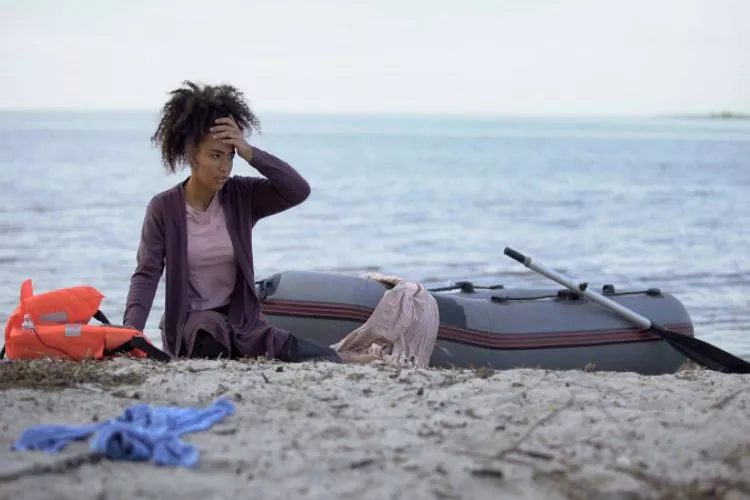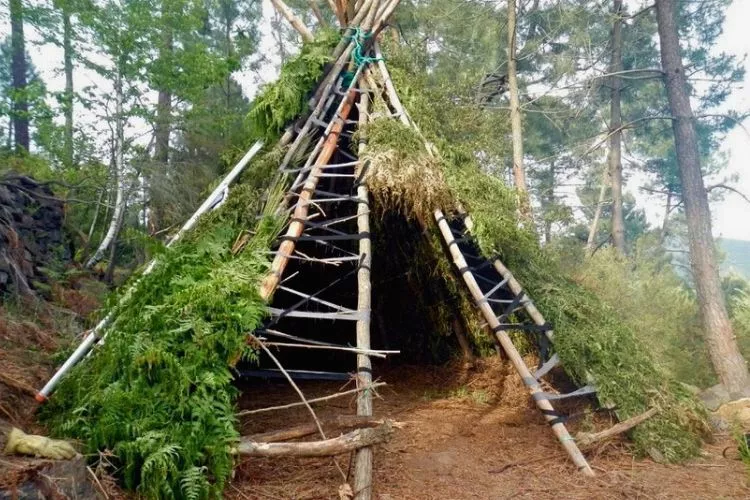Stranded. Deserted. Isolated. You find yourself marooned on an uninhabited island. Scenes from the movie Cast Away might be flashing before your eyes but don’t let panic set in. Here’s a practical guide to how to survive on a deserted island.
This article will neither show you how to befriend a volleyball nor grow an impressive beard like Tom Hanks.

Instead, it outlines practical, life-saving tips, learned from countless survival specialists, for those unforeseen situations where you might find yourself fighting for survival, crippled by isolation.
From finding water to lighting a fire, let’s delve deep into mastering the art of surviving on a deserted island.
how to survive on a deserted island?
surviving on a deserted island is no easy task, but with the right mindset and knowledge, you can transform it into a more manageable experience.
Mastering the essentials – shelter, water, food, and fire – will greatly increase your chances of survival while protecting you from the elements. Remember, staying calm and clear-headed is paramount to your success.
Hopefully, these lessons have equipped you with the skills to tackle any obstacles you might face in such a scenario. In the end, the goal is simple—adapt, endure, and be ready to thrive until rescue arrives.
Assess your situation
Once you find yourself stranded on a deserted island, it’s important not to panic. Take a few deep breaths and try to calmly assess your situation. Take stock of what supplies and resources you have with you.
Check yourself for any injuries sustained during your arrival on the island. Look around for immediate threats, like dangerous animals, or urgent needs for shelter or fresh water.

Try to get your bearings and identify any noticeable landmarks or potential sources of food and water. Making a methodical assessment of your situation is crucial before taking any further steps to ensure your survival.
Don’t let fear overwhelm you – take it step by step and focus on gathering information. With a level head, you can better prioritize your next actions. Remain as positive as possible – you can get through this situation.
Find fresh water
Fresh water is essential for survival on a deserted island. Look around the island for natural springs. Springs often emerge from cracks in rocks or out of the ground.
Rain catchments are another great option. Use large leaves or hollowed out wood to collect rainwater. Morning dew can also be collected using absorbent cloth.
Before drinking any found water, it’s crucial to filter and purify it. Boiling is the safest method if you have a metal container. Boil for at least 1 minute.
Alternatively, create a basic filter by layering sand, gravel, charcoal, and cloth. This will remove some contaminants. Adding a few drops of bleach or iodine per liter will further disinfect the water.
Drinking unsafe water can cause serious illnesses like giardia. Be absolutely certain your water is purified before consuming. Staying hydrated is vital, so make finding and purifying fresh water a top priority when stranded on a deserted island.
Build Shelter
One of the most important steps when trying to survive on a deserted island is building a shelter. Your shelter needs to protect you from the elements, including the sun, wind, and rain.
The best shelters are built using natural materials found on the island itself, like leaves, branches, vines, bark, and other debris.
When choosing where to build your shelter, look for a location that provides some natural protection, like being nestled against a rock wall or under the canopy of trees.

Also try to build on high ground to avoid flooding during storms. Face the opening of the shelter away from the prevailing winds.
Use logs, rocks, vines, and leaves to assemble the frame of the shelter. Palms and other large leafy branches are great to use as thatch for the roof and walls.
Layer the thatch to make it thick and waterproof. Leave gaps to allow airflow and prevent mold. Pack mud or small rocks between the thatch to help it remain sturdy.
A simple lean-to is an easy survival shelter to build. Drive tall stakes into the ground, angled back against a support like a large boulder or tree trunk.
Layer on thatch for the roof, leaving an opening in the front. Build up the sides with more stakes and thatch as needed. Having sturdy and protective shelter is crucial when trying to survive on a deserted island.
Natural, available materials can be used to create an effective shelter that protects you from the elements. Choose a good location and reinforce the shelter as needed. A lean-to is a good starter option that can be expanded over time. With effort and ingenuity, you can build a shelter that will help keep you alive.
Start a Fire
Fire is critical for cooking, warmth, and signaling while stranded on a deserted island. There are several methods you can use to start a fire if you don’t have matches or a lighter with you.
One of the most primitive but effective ways is using a hand drill or bow drill. This involves rubbing a stick against a flat piece of wood to create friction and sawdust that will eventually ignite.
It takes practice but can be done with only natural materials found on the island. Look for a sturdy stick and board that are dry and softwoods like cedar or pine.
Another option is striking a piece of flint or quartz against high-carbon steel from a knife or tool. This causes sparks that can ignite dry tinder. If you don’t have flint or steel, you may be able to use eyeglasses or bottle bottoms to focus sunlight onto tinder as a magnifying glass.
The most important thing is having good tinder, kindling, and fuel prepared before trying to ignite a fire. Tinder should be extremely fine and dry material like grass, bark, moss, or bird down that will catch the smallest spark.
Kindling needs to include small dry twigs and sticks that ignite quickly from the tinder. Fuel means larger sticks and logs that will sustain the fire.
Take time gathering the full range of materials needed in sufficient amounts before attempting to start a fire. This process takes patience but is essential for cooking, light, warmth, and being spotted by search parties.
Never give up hope. With practice you can successfully start fires using only primitive tools and materials on a deserted island.
Signal for Help
Signaling for help is crucial to being rescued from a deserted island. Here are some tips for signaling rescuers:
Use mirrors and fires to reflect and shine light to planes and ships You can craft a simple mirror by angling a piece of reflective metal or glass towards the sun. Build 3 fires in a triangle formation – the smoke in the day and light at night will be visible for miles.

Make SOS signs and other ground markers for helicopters and boats. Use rocks, logs, or vegetation to make large SOS signs and arrows in open sandy areas. Make the signs at least 9 feet long per letter. Shape arrows pointing towards your main camp.
Stay near your shelter but have open visibility. This allows rescuers to spot you if they are nearby. Staying near your shelter means you have ready access to food, water and fire. But also try to camp in an area with open visibility to the ocean.
The most important aspect is to never give up hope. Maintain your signals and markers diligently. Stay strong knowing that rescuers could find you at any moment. With preparation and persistence, you can survive on an island until help arrives.
Find Food
Fishing, setting traps, and spear fishing are some of the most effective ways to find a consistent food source on a deserted island.
Look for visible fish near shore or in tidal pools that you can catch with your hands. Construct a basic fishing spear by sharpening and fire-hardening the end of a straight stick. Stand motionless in shallow water and wait for fish to come near, then spear them swiftly.
You can also fashion hooks from shells, bones, thorns, or pieces of metal and make fishing line from natural fibers, hair, or thin vines. Tie one end to a flexible tree branch and the other end to the hook. Bait the hook with grubs, small fish, or pieces of fruit and lower it into pools and eddies where fish gather.
Trapping small game takes patience but can provide a good source of protein. Look for small animal tracks and burrows and set snares using vine, hair, or plant fibers. Dig shallow pits and cover them with branches and leaves to catch unsuspecting prey.
You can also fashion traps from natural materials like heavy rocks and logs. Check traps frequently but avoid areas with large animal tracks, which could indicate predators.
Identifying edible plants takes trial and error, so proceed carefully. Look for familiar fruits, herbs, mushrooms, and green leafy plants. Avoid plants with thorns, milky sap, bean-like pods, bitter taste, or almond scent, as these could be toxic.
Start with small portions of new plants to test for any reaction. Boil unknown plants to remove toxins and pathogens. Stretch limited food by eating perishables first, portioning supplies, and consuming all edible parts of plants and animals. With creativity and persistence, the island can sustain you until rescue arrives.
Maintain health
Staying healthy is critical to survival on a deserted island. Without access to medical care, even a small injury or illness can become life-threatening. Focus on the following to maintain health:
Avoid infections and diseases. Be vigilant about cleaning any wounds with boiled water. Look for anti-septic plants to create poultices. Stay hydrated and get adequate nutrition. Try to avoid bug bites.
Improvise first aid. Use a shirt as a sling for broken bones. Apply pressure to stop bleeding. Immobilize sprained joints. Clean and cover wounds. You can even stitch wounds with plant fibers or hair.
Manage mental health. Isolation can lead to anxiety, depression and despair. Combat this by keeping a positive attitude and focusing on survival tasks. Set daily goals. Maintain a routine. Journal thoughts and feelings. Meditate and practice deep breathing.
Staying healthy takes discipline and positivity. But your life depends on it. Care for your body and mind in this extreme situation. Don’t give up hope – you can survive and stay strong.
Weather Storms
When a storm hits, your survival depends on being prepared. Having robust shelter and supplies on hand can be the difference between riding out a storm safely or putting yourself in grave danger.
As a storm approaches, prepare your shelter by securing anything that could blow away and clearing debris from around the shelter’s exterior.

Make sure the shelter’s roof and walls are reinforced and leak-proof. Stock up on clean water, food rations, medicine, batteries, and other essentials so you can hunker down until the storm passes.
If flooding is a threat, get to high ground before the storm hits. Find a hill, rock ledge, or elevated tree safe from wind damage and surging waters.
Wait out the storm there if you cannot reach your shelter in time. Avoid valleys, canyons, and low-lying areas prone to flash floods.
Stay inside a sealed shelter during the storm’s peak. Do not leave safety to retrieve items from outside. Wait for the storm to fully pass before carefully emerging to survey and address any damage.
With robust preparation and supplies, you can safely ride out storms on a deserted island. Stay alert to weather forecasts and proactively prepare.
Plan and prepare
Planning and preparation can help you survive longer on a deserted island. Setting clear goals and priorities will provide focus and motivation. Maintain any skills or fitness that may be useful, whether it’s swimming, climbing, or staying mentally sharp.
Gather materials and make tools in advance so you’re ready to act when needed. You may be stuck for a while, so try to establish some sense of normalcy and routine. But also be ready to adapt to changing circumstances.
Planning reduces panic and helps you make logical decisions. Stay observant of your surroundings and changing conditions. Continuously evaluate your situation and options.
With preparation and an open mind, you’ll be ready for whatever comes your way. The key is to not lose hope. Stay focused on getting through each challenge, moment by moment.
Never give up hope
Staying mentally strong and optimistic is crucial to surviving on a deserted island until you get rescued. It’s important not to lose hope or fall into despair.
Attempt to make contact with rescuers at least once daily, whether it’s lighting a signal fire, reflecting light with a mirror, or waving brightly colored clothing. Keep trying every method you can think of. Maintain faith that you will be found if you diligently follow your survival plan.
Believe that rescue will come and visualize your return home. Focus on your loved ones and happy memories. Singing, meditation, exercise or keeping a journal can also help you stay positive.
Don’t allow negative thoughts to take hold. With preparation, supplies and a survival mindset, you can survive this ordeal. Your chances are good if you stay determined. Never give up hope!
Other survival guide: How to Survive a Whirlpool | Can You Survive on Rice and Beans?
Conclusion:
As we wrap up our exploration of survival strategies on a deserted island, it’s clear that preparation and adaptability are crucial to stay alive.
Combining our newfound knowledge of finding water, food, crafting tools, and building a shelter with a positive attitude, we can withstand isolation, hunger, and fear.
Reinforcing our commitment to learn and grow from these experiences, we emerge stronger and more capable of facing life’s challenges.


